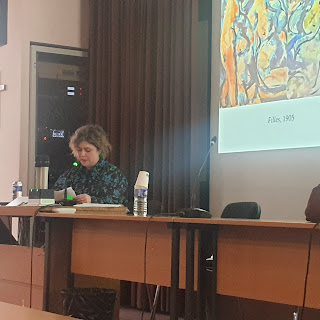Many contemporary artists regard their work as having a moral as well as an aesthetic function. They conceive of the artist as a visual truth-teller who exposes social and spiritual injustice, and through their work these artists envision a more perfect world. This prophetic role for the artist can, in part, be rooted in figures of Jewish and Christian prophets, from Abraham, Moses, and Isaiah to John the Baptist, Stephen, and others. These prophets model a non-cynical intersection of spiritual purpose and material action that continues to inspire artists to work both within and beyond the studio/gallery/museum with a belief that art can call a reimagined reality into being.
The symposium featured presentations exploring the work of post-World War II artists whose work can be understood in relation to a Judeo-Christian model of prophetic social and spiritual action, such as that taken up by French modernist Georges Rouault. The presentations in the symposium focused on artists and theorists who extend and expand this legacy of Rouault.
The keynote presentation on The Artist as Truth Teller: From Georges Rouault to the Present was given by Prof. Jérôme Cottin (Université de Strasbourg).
The other presentations included:
- Christine Gouzi (Université Paris-Sorbonne), “Georges Rouault, de la peinture à l’écriture: Soliloques d’un peintre”
- Denis Hétier (Institut Catholique de Paris), “L’ordre intérieur de l’artiste: Vers une réflexion théologique sur Georges Rouault et Pie-Raymond Regamey”
- William Dyrness (Fuller Theological Seminary), “Maritain and Rouault: Who Influenced Whom? A study of Literary and Visual Relationships”
- Julie Hamilton (Foundation for Spirituality and the Arts), “Georges Rouault’s Rebellion: Empathy as Social Critique”
- Pierre-Emmanuel Perrier de la Bâthie (Institut Catholique de Paris), “L’artiste comme prophète en son temps: Les références chrétiennes dans l’œuvre de Joseph Beuys”
- Jonathan Evens (Wickford and Runwell Team Ministry), “True Humility is Not Mediocrity”
- Monica Keska (University of Granada), “Go Down Moses: Biblical Imagery in the Works of Aaron Douglas”
- James Romaine (Lander University), “Validating Experiences: Romare Bearden’s Creative Purpose”
- Linda Stratford (Asbury University), “George Rouault’s Legacy of Artistic Mediation and Spiritual Purpose”
Although he enjoyed considerable recognition in his own day and time, the reputation of Girard has diminished with time, unlike that of Rouault. As a result, his work is ripe for rediscovery. In this paper, in addition to highlighting key strands of Rouault’s influence on Girard such as humility and risk taking, I explored some of the reasons why Rouault’s work transcends his age, while that of Girard seems to remain within his. Additionally, I shared the contrasts in their work noted by their friend André Suares - penitence and affirmation.
----------------------------------------------------------------------------------------------------------
Erik Satie - Messe de Pauvres.



.jpg)

No comments:
Post a Comment